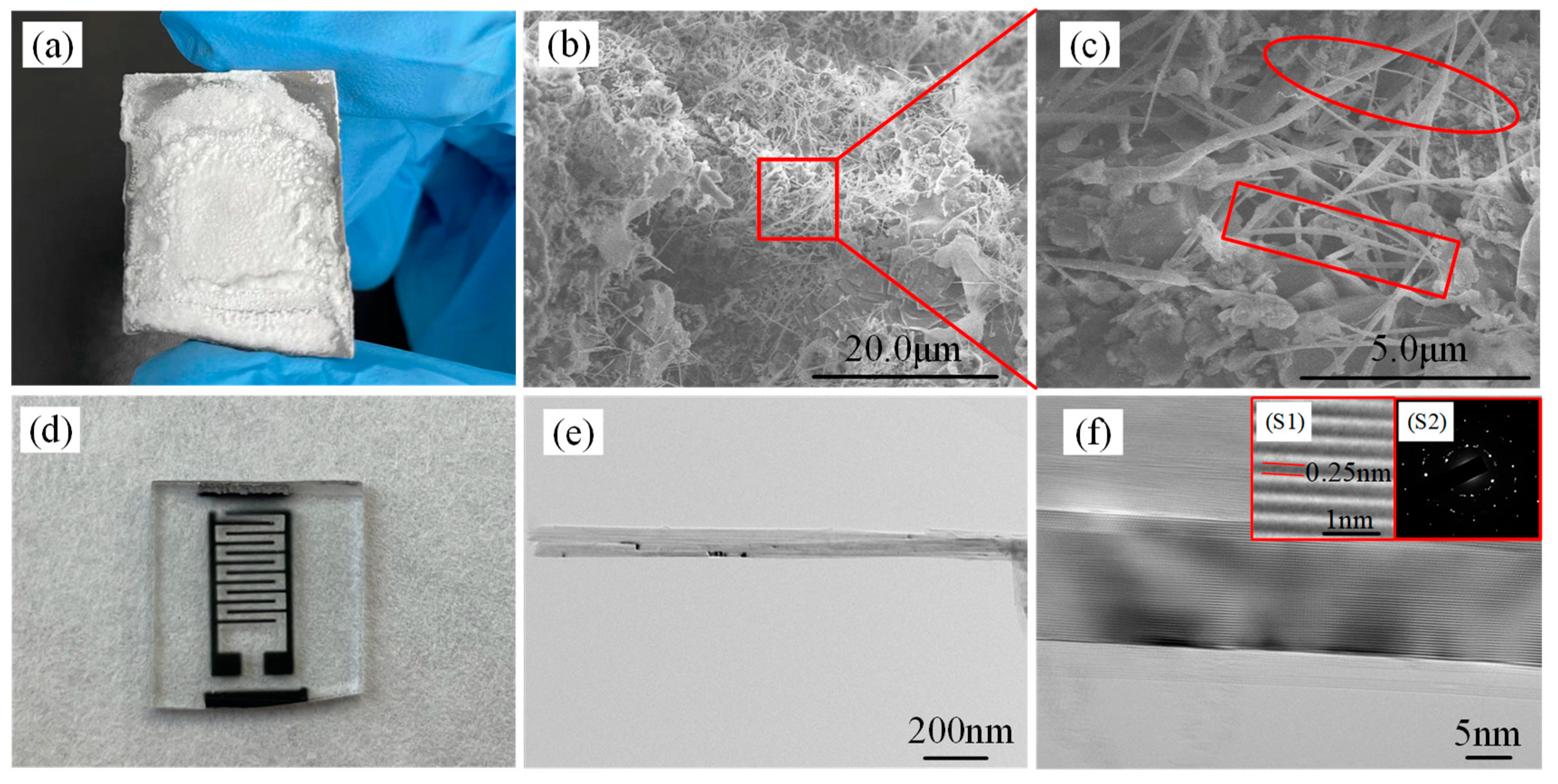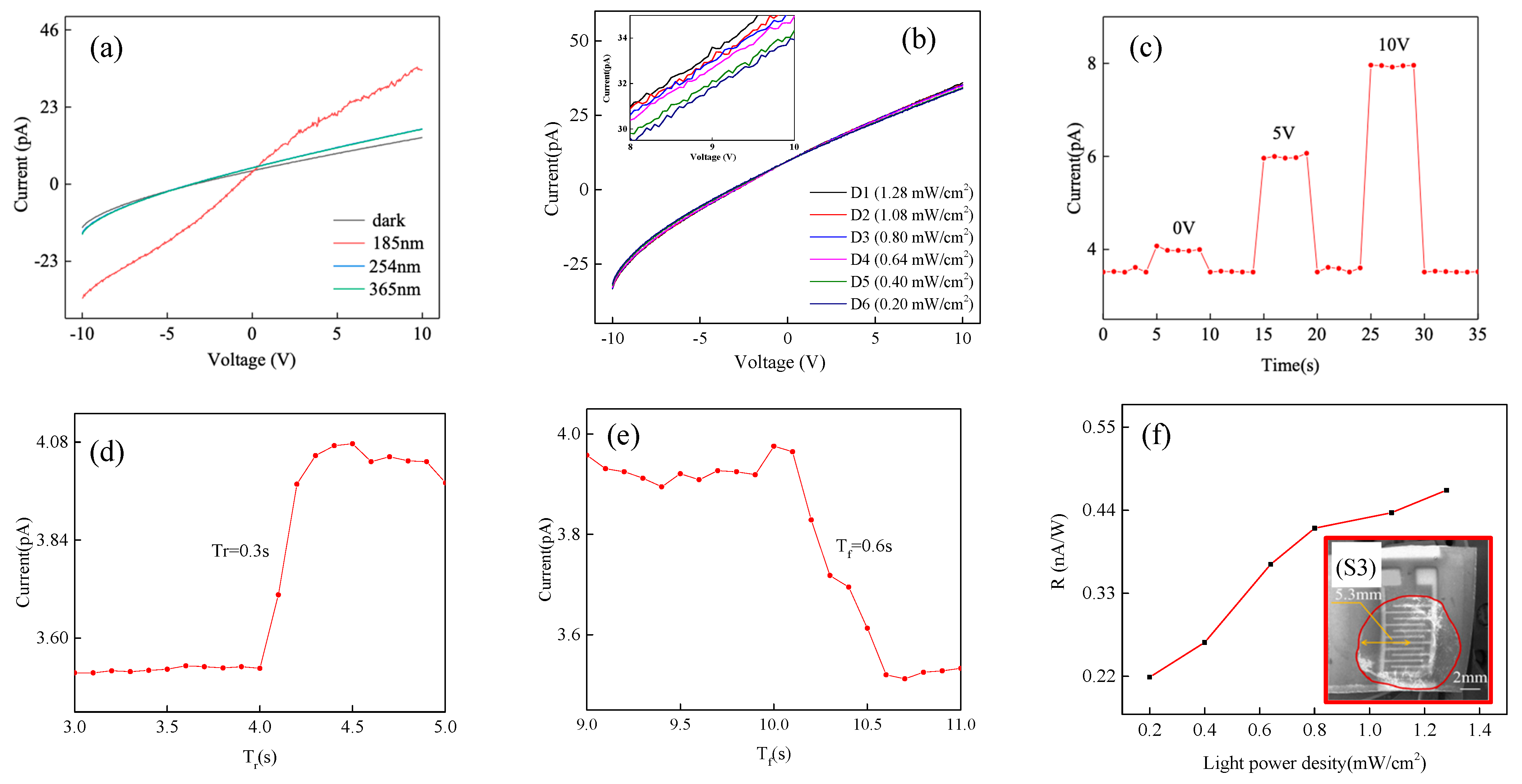Boron Nitride Nanoribbons Grown by Chemical Vapor Deposition for VUV Applications
Abstract
:1. Introduction
2. Experimental Section
2.1. Preparation of Boron Nitride Nanoribbons
2.2. Device Fabrication
3. Results and Discussion
3.1. Characterization of Boron Nitride Nanoribbons
3.2. Characterization of the Vacuum Ultraviolet Detector-Based Boron Nitride Nanoribbons
4. Conclusions
Author Contributions
Funding
Conflicts of Interest
References
- Chen, M.; Zhao, B.; Hu, G.; Fang, X.; Wang, H.; Wang, L.; Luo, J.; Han, X.; Wang, X.; Pan, C.; et al. Piezo-phototronic effect modulated deep UV photodetector based on ZnO-Ga2O3 heterojuction microwire. Adv. Funct. Mater. 2018, 28, 1706379. [Google Scholar] [CrossRef]
- Mori, M.; Hamamoto, A.; Takahashi, A.; Kinouchi, Y.; Yagi, N.; Akutagawa, M.; Ikehara, T.; Nakano, M.; Tachibana, S. Development of a new water sterilization device with a 365 nm UV-LED. Med. Biol. Eng. Comput. 2008, 45, 1237–1241. [Google Scholar] [CrossRef] [PubMed]
- Baek, S.; Choi, E.; Baek, Y.; Lee, C. Detection of counterfeit banknotes using multispectral images. Digit. Signal Process. 2018, 78, 294–304. [Google Scholar] [CrossRef]
- Chen, H.; Liu, H.; Zhang, Z.; Hu, K.; Fang, X. Nanostructured photodetectors: From ultraviolet to terahertz. Adv. Mater. 2016, 28, 403–433. [Google Scholar] [CrossRef]
- Zheng, W.; Jia, L.; Huang, F. Vacuum-Ultraviolet Photon Detections. iScience 2020, 23, 101145. [Google Scholar]
- Zheng, W.; Huang, F.; Zheng, R.; Wu, H. Low-Dimensional Structure Vacuum-Ultraviolet-Sensitive (λ < 200 nm) Photodetector with Fast-Response Speed Based on High-Quality AlN Micro/Nanowire. Adv. Mater. 2015, 27, 3921–3927. [Google Scholar]
- Zhou, C.; Lai, C.; Zhang, C.; Zeng, G.; Huang, D.; Cheng, M.; Hu, L.; Xiong, W.; Chen, M.; Wang, J.; et al. Semiconductor/boron nitride composites: Synthesis, properties, and photocatalysis applications. Appl. Catal. B Environ. 2018, 238, 6–18. [Google Scholar] [CrossRef]
- Chen, T.; Zhang, Q.; Xie, Z.; Tan, C.; Chen, P.; Zeng, Y.; Wang, F.; Liu, H.; Liu, Y.; Liu, G.; et al. Carbon nitride modified hexagonal boron nitride interface as highly efficient blue LED light-driven photocatalyst. Appl. Catal. B Environ. 2018, 238, 410–421. [Google Scholar] [CrossRef]
- He, Z.; Kim, C.; Lin, L.; Jeon, T.; Lin, S.; Wang, X.; Choi, W. Formation of heterostructures via direct growth CN on h-BN porous nanosheets for metal-free photocatalysis. Nano Energy 2017, 42, 58–68. [Google Scholar] [CrossRef]
- Li, W.; Wang, Q.; Huang, L.; Li, Y.; Xu, Y.; Song, Y.; Zhang, Q.; Xu, H.; Li, H. Synthesis and characterization of BN/Bi2WO6 composite photocatalysts with enhanced visible-light photocatalytic activity. RSC Adv. 2015, 5, 88832–88840. [Google Scholar] [CrossRef]
- Li, W.; Liu, Y.; Di, J.; Ji, M.; Xia, J.; Li, H. Graphene-Analogue Boron Nitride Modified Bismuth Oxyiodide with Increased Visible-Light Photocatalytic Performance. Phys. Status Solidi 2018, 215, 1800146. [Google Scholar] [CrossRef]
- Chen, Z.; Chen, X.; Di, J.; Liu, Y.; Yin, S.; Xia, J.; Li, H. Graphene-like boron nitride modified bismuth phosphate materials for boosting photocatalytic degradation of enrofloxacin. Colloid Interface Sci. 2017, 492, 51–60. [Google Scholar] [CrossRef] [PubMed]
- Ji, M.; Xia, J.; Di, J.; Liu, Y.; Chen, Z.; Yin, S.; Li, H. Graphene-like boron nitride induced accelerated charge transfer for boosting the photocatalytic behavior of Bi4O5I2 towards bisphenol a removal. Chem. Eng. J. 2018, 331, 355–363. [Google Scholar] [CrossRef]
- Rivera, M.; Velázquez, R.; Aldalbahi, A.; Zhou, A.; Feng, P. UV photodetector based on energy bandgap shifted hexagonal boron nitride nanosheets for high-temperature environments. J. Phys. D Appl. Phys. 2018, 51, 045102. [Google Scholar] [CrossRef]
- Knobloch, T.; Illarionov, Y.; Ducry, F.; Schleich, C.; Wachter, S.; Watanabe, K.; Taniguchi, T.; Mueller, T.; Waltl, M.; Lanza, M.; et al. The performance limits of hexagonal boron nitride as an insulator for scaled CMOS devices based on two-dimensional materials. Nat. Electron. 2021, 4, 98–108. [Google Scholar] [CrossRef]
- Xu, T.; Zhang, K.; Cai, Q.; Wang, N.; Wu, L.; He, Q.; Wang, H.; Zhang, Y.; Xie, Y.; Yao, Y.; et al. Advances in synthesis and applications of boron nitride nanotubes: A review. Chem. Eng. J. 2022, 431, 134118. [Google Scholar] [CrossRef]
- Cassabois, G.; Valvin, P.; Gil, B. Hexagonal boron nitride is an indirect bandgap semiconductor. Nat. Photonics 2016, 10, 262–266. [Google Scholar] [CrossRef] [Green Version]
- Gao, X.; Yao, Y.; Meng, X. Recent development on BN-based photocatalysis: A review. Mater. Sci. Semicond. Process. 2020, 120, 105256. [Google Scholar] [CrossRef]
- Li, L.; Li, L.; Chen, Y.; Dai, X.; Lamb, P.; Cheng, B.; Lin, M.; Liu, X. High-Quality Boron Nitride Nanoribbons: Unzipping during Nanotube Synthesis. Angew. Chem. Int. Ed. 2013, 125, 4306–4310. [Google Scholar] [CrossRef]
- Kim, D.; Nakajima, S.; Sawada, T.; Lwasaki, M.; Zhi, C.; Bando, Y.; Golberg, D.; Serizawa, T. Sonication-assisted alcoholysis of boron nitride nanotubes for their sidewalls chemical peeling. Chem. Commun. 2015, 51, 7104–7107. [Google Scholar] [CrossRef] [Green Version]
- Lin, Y.; Connell, J.W. Advances in 2D boron nitride nanostructures: Nanosheets, nanoribbons, nanomeshes, and hybrids with graphene. Nanoscale 2012, 4, 6908–6939. [Google Scholar] [CrossRef] [PubMed]
- Maity, A.; Grenadier, S.; Li, J.; Lin, J.; Jiang, H. Hexagonal boron nitride: Epitaxial growth and device applications. Prog. Quantum Electron. 2020, 76, 100302. [Google Scholar] [CrossRef]
- Li, J.; Majety, S.; Dahal, R.; Zhao, W.; Lin, J.; Jiang, H. Dielectric strength, optical absorption, and deep ultraviolet detectors of hexagonal boron nitride epilayers. Appl. Phys. Lett. 2012, 101, 67–92. [Google Scholar] [CrossRef] [Green Version]
- Aldalbahi, A.; Feng, P. Development of 2-D boron nitride nanosheets UV photoconductive detectors. IEEE Trans. Electron. Devices 2015, 62, 1885–1890. [Google Scholar] [CrossRef]
- Jiang, X.; Ban, C.; Li, L.; Chen, W.; Liu, X. Research on ohmic contact characteristics of single boron nitride nanoribbon. J. Nanopart. Res. 2021, 23, 242. [Google Scholar] [CrossRef]
- Sinitskii, A.; Erickson, K.; Lu, W.; Gibb, A.; Zhi, C.; Bando, Y.; Golberg, D.; Zettl, A.; Tour, J. High-Yield Synthesis of Boron Nitride Nanoribbons via Longitudinal Splitting of Boron Nitride Nanotubes by Potassium Vapor. ACS Nano 2014, 8, 9867–9873. [Google Scholar] [CrossRef]
- Chen, Z.; Zou, J.; Liu, G.; Li, F.; Wang, Y.; Wang, L.; Yuan, X.; Sekiguchi, T.; Cheng, H.; Lu, G.; et al. Novel boron nitride hollow nanoribbons. ACS Nano 2008, 2, 2183–2191. [Google Scholar] [CrossRef]
- Rivera, M.; Velázquez, R.; Aldalbahi, A.; Zhou, A.; Feng, P. High Operating Temperature and Low Power Consumption Boron Nitride Nanosheets Based Broadband UV Photodetector. Sci. Rep. 2017, 7, 42973. [Google Scholar] [CrossRef] [Green Version]
- Weng, Q.; Wang, X.; Bando, Y.; Golberg, D. One-Step Template-Free Synthesis of Highly Porous Boron Nitride Microsponges for Hydrogen Storage. Adv. Energy Mater. 2014, 4, 1301525. [Google Scholar] [CrossRef]
- Li, M.; Li, N.; Xu, G.; Zhao, L.; Chen, X.; Zhao, Y.; Zhao, R. Magnetic boron nitride nanosheets as a novel magnetic solid-phase extraction adsorbent for the determination of plant growth regulators in tomatoes. Food Chem. 2021, 348, 129103. [Google Scholar] [CrossRef]
- Yue, W.; Li, Z.; Li, P.; Zhou, X.; Wang, Y.; Wu, J.; Bai, J. Ion beam sputtering-deposited thermally annealed h-BN transferred film for improving GaN crystal quality. Mater. Chem. Phys. 2022, 275, 125143. [Google Scholar] [CrossRef]
- Zheng, W.; Lin, R.; Zhang, Z.; Huang, F. Vacuum-ultraviolet photodetection in few- layered h-BN. ACS Appl. Mater. Interfaces 2018, 10, 27116–27123. [Google Scholar] [CrossRef] [PubMed]
- Zeng, H.; Zhi, C.; Zhang, Z.; Wei, X.; Wang, X.; Guo, W.; Bando, Y.; Golberg, D. “White Graphenes”: Boron Nitride Nanoribbons via Boron Nitride Nanotube Unwrapping. Nano Lett. 2010, 10, 5049–5055. [Google Scholar] [CrossRef] [PubMed]
- Jiang, X.; Ban, C.; Li, L.; Hao, J.; Chen, Z.; Li, X.; Chen, W.; Liu, X. Synthesis of high porosity and high adsorption performance BNNRs aerogels with long straight and their application for water cleaning. Diam. Relat. Mater. 2021, 120, 108649. [Google Scholar] [CrossRef]
- Gorbachev, R.; Riaz, I.; Nair, R.; Jalil, R.; Britnell, L.; Belle, B.; Hill, E.; Novoselov, K.; Watanabe, K.; Taniguchi, T.; et al. Hunting for Monolayer Boron Nitride: Optical and Raman Signatures. Small 2011, 7, 465–468. [Google Scholar] [CrossRef] [Green Version]
- Watanabe, K.; Taniguchi, T.; Kanda, H. Direct-bandgap properties and evidence for ultraviolet lasing of hexagonal boron nitride single crystal. Nat. Mater. 2004, 3, 404–409. [Google Scholar] [CrossRef]
- Ahmed, K.; Dahal, R.; Weltz, A.; Lu, J.; Danon, Y.; Bhat, I. Metalorganic chemical vapor deposition of hexagonal boron nitride on (001) sapphire substrates for thermal neutron detector applications. Vacuum 2016, 137, 81–84. [Google Scholar] [CrossRef] [Green Version]
- BenMoussa, A.; Hochedez, J.; Dahal, R.; Li, J.; Lin, J.; Jiang, H.; Soltani, A.; Jaeger, J.; Kroth, U.; Richter, M.; et al. Characterization of AlN Metal-Semiconductor-Metal Diodes in the Spectral Range of 44–360 nm: Photoemission Assessments. Appl. Phys. Lett. 2008, 92, 022108. [Google Scholar]
- Balducci, A.; Marinelli, M.; Milani, E.; Morgada, M.; Tucciarone, A.; Verona-Rinati, G.; Angelone, M.; Pillon, M. Extreme Ultraviolet Single-Crystal Diamond Detectors by Chemical Vapor Deposition. Appl. Phys. Lett. 2005, 86, 193509. [Google Scholar] [CrossRef]
- Li, Y.Q.; Guo, J.M.; Zheng, W. Amorphous boron nitride for vacuum-ultraviolet photodetection. Appl. Phys. Lett. 2020, 117, 023504. [Google Scholar]
- Li, Y.; Guo, J.; Zheng, W.; Huang, F. Graphene interdigital electrodes for improving sensitivity in a Ga2O3: Zn deepultraviolet photoconductive detector. ACS Appl. Mater. Interface 2019, 11, 1013–1020. [Google Scholar] [CrossRef] [PubMed]
- Li, Y.; Zhong, W.; Zheng, W.; Huang, F. Silicon Nitride Deep-Ultraviolet Photoconductive Detector. IEEE Electron. Device Lett. 2020, 41, 1316–1319. [Google Scholar] [CrossRef]
- Gan, L.; Liao, M.; Li, H.; Ma, Y.; Zhai, T. Geometry-induced high performance ultraviolet photodetectors in kinked SnO2 nanowires. J. Mater. Chem. C 2015, 3, 8300–8306. [Google Scholar] [CrossRef]
- Zou, Y.; Zhang, Y.; Hu, Y.; Gu, H. Ultraviolet Detectors Based on Wide Bandgap Semiconductor Nanowire: A Review. Sensors 2018, 18, 2072. [Google Scholar] [CrossRef] [Green Version]



Publisher’s Note: MDPI stays neutral with regard to jurisdictional claims in published maps and institutional affiliations. |
© 2022 by the authors. Licensee MDPI, Basel, Switzerland. This article is an open access article distributed under the terms and conditions of the Creative Commons Attribution (CC BY) license (https://creativecommons.org/licenses/by/4.0/).
Share and Cite
Hao, J.; Li, L.; Gao, P.; Jiang, X.; Ban, C.; Shi, N. Boron Nitride Nanoribbons Grown by Chemical Vapor Deposition for VUV Applications. Micromachines 2022, 13, 1372. https://doi.org/10.3390/mi13091372
Hao J, Li L, Gao P, Jiang X, Ban C, Shi N. Boron Nitride Nanoribbons Grown by Chemical Vapor Deposition for VUV Applications. Micromachines. 2022; 13(9):1372. https://doi.org/10.3390/mi13091372
Chicago/Turabian StyleHao, Jiandong, Ling Li, Peng Gao, Xiangqian Jiang, Chuncheng Ban, and Ningqiang Shi. 2022. "Boron Nitride Nanoribbons Grown by Chemical Vapor Deposition for VUV Applications" Micromachines 13, no. 9: 1372. https://doi.org/10.3390/mi13091372
APA StyleHao, J., Li, L., Gao, P., Jiang, X., Ban, C., & Shi, N. (2022). Boron Nitride Nanoribbons Grown by Chemical Vapor Deposition for VUV Applications. Micromachines, 13(9), 1372. https://doi.org/10.3390/mi13091372






